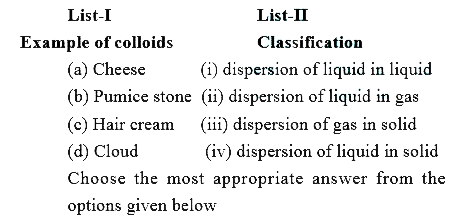Given below are two statements :
Statement I : Potassium permanganate on heating at 500K forms potassium manganate.
Statement II : Both potasium permanganate and potassium manganate are tetrahedral and paramaganetic in nature.
In the light of the above statement, choose the most appropriate answer from the options given below :
Both statement I and statement II are true
Both statement I and statement II are false
Statement I is true but statement II is false
Statement I is false but statement II is true
To solve the question, we need to analyze both statements provided regarding potassium permanganate (KMnO4) and potassium manganate (K2MnO4).
Step 1: Analyze Statement I
- Statement I claims that potassium permanganate (KMnO4) decomposes to form potassium manganate (K2MnO4) upon heating at 500K.
- The decomposition reaction can be written as:
2KMnO4(s)→K2MnO4(s)+MnO2(s)+O2(g)
- This reaction indicates that KMnO4 does indeed decompose to form K2MnO4, along with manganese dioxide (MnO2) and oxygen gas (O2).
- Therefore, Statement I is correct.
Step 2: Analyze Statement II
- Statement II states that both potassium permanganate (KMnO4) and potassium manganate (K2MnO4) are tetrahedral and paramagnetic.
- First, we need to determine the oxidation states of manganese in both compounds:
- For KMnO4:
- The oxidation state of Mn can be calculated as follows:
x+4(−2)=−1⟹x−8=−1⟹x=+7
- The electron configuration of Mn in +7 oxidation state is Argon (Ar) 3d^0 4s^0, which means it has no unpaired electrons. Thus, KMnO4 is diamagnetic, not paramagnetic.
- For K2MnO4:
- The oxidation state of Mn can be calculated as follows:
x+4(−2)=−2⟹x−8=−2⟹x=+6
- The electron configuration of Mn in +6 oxidation state is Argon (Ar) 3d^5 4s^0. This configuration has one unpaired electron, making K2MnO4 paramagnetic.
- Regarding the geometry:
- KMnO4 has a tetrahedral geometry due to its structure as an anionic complex (MnO4^-).
- K2MnO4 also has a tetrahedral geometry due to its structure as an anionic complex (MnO4^2-).
- However, since KMnO4 is diamagnetic and not paramagnetic, Statement II is incorrect.
Conclusion:
- Statement I is correct.
- Statement II is incorrect.
Thus, the most appropriate answer is that Statement I is correct and Statement II is incorrect.
- Statement I claims that potassium permanganate (KMnO4) decomposes to form potassium manganate (K2MnO4) upon heating at 500K.
- The decomposition reaction can be written as:
2KMnO4(s)→K2MnO4(s)+MnO2(s)+O2(g)
- This reaction indicates that KMnO4 does indeed decompose to form K2MnO4, along with manganese dioxide (MnO2) and oxygen gas (O2).
- Therefore, Statement I is correct.
- Statement II states that both potassium permanganate (KMnO4) and potassium manganate (K2MnO4) are tetrahedral and paramagnetic.
- First, we need to determine the oxidation states of manganese in both compounds:
- For KMnO4:
- The oxidation state of Mn can be calculated as follows:
x+4(−2)=−1⟹x−8=−1⟹x=+7
- The electron configuration of Mn in +7 oxidation state is Argon (Ar) 3d^0 4s^0, which means it has no unpaired electrons. Thus, KMnO4 is diamagnetic, not paramagnetic.
- For K2MnO4:
- The oxidation state of Mn can be calculated as follows:
x+4(−2)=−2⟹x−8=−2⟹x=+6
- The electron configuration of Mn in +6 oxidation state is Argon (Ar) 3d^5 4s^0. This configuration has one unpaired electron, making K2MnO4 paramagnetic.
- Regarding the geometry:
- KMnO4 has a tetrahedral geometry due to its structure as an anionic complex (MnO4^-).
- K2MnO4 also has a tetrahedral geometry due to its structure as an anionic complex (MnO4^2-).
- However, since KMnO4 is diamagnetic and not paramagnetic, Statement II is incorrect.
- Statement I is correct.
- Statement II is incorrect.
Topper's Solved these Questions
- JEE MAIN 2021BOOK - JEE MAINS PREVIOUS YEARCHAPTER - JEE MAIN 2021EXERCISE - CHEMISTRY (SECTION B)
20 Videos
- JEE MAIN 2021BOOK - JEE MAINS PREVIOUS YEARCHAPTER - JEE MAIN 2021EXERCISE - CHEMISTRY SECTION A
60 Videos
- JEE MAIN 2021BOOK - JEE MAINS PREVIOUS YEARCHAPTER - JEE MAIN 2021EXERCISE - CHEMISTRY (SECTION-B)
10 Videos
- JEE MAINBOOK - JEE MAINS PREVIOUS YEARCHAPTER - JEE MAINEXERCISE - CHEMISTRY
150 Videos
- JEE MAIN 2022BOOK - JEE MAINS PREVIOUS YEARCHAPTER - JEE MAIN 2022EXERCISE - Question
561 Videos
Similar Questions
Knowledge Check
Match List - I with List- II
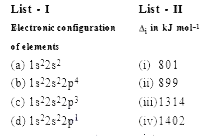
Choose the most appropriate answer from the options given below -A(a)→(ii),(b)→(iii),(c)→(iv),(d)→(i)B(a)→(i),(b)→(iv),(c)→(iii),(d)→(ii)C(a)→(i),(b)→(iii),(c)→(iv),(d)→(ii)D(a)→(iv),(b)→(i),(c)→(ii),(d)→(iii)Match List - I with List- II
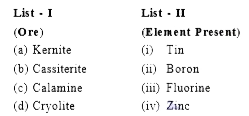
Choose the most appropriate answer from the options given below -A(a)→(i),(b)→(iii),(c)→(iv),(d)→(ii)B(a)→(ii),(b)→(i),(c)→(iv),(d)→(iii)C(a)→(ii),(b)→(iv),(c)→(i),(d)→(iii)D(a)→(iii),(b)→(i),(c)→(ii),(d)→(iv)
Match List-I with List -II

Choose the most appropriate answer from the options given below:
View SolutionMatch List - I with List - II
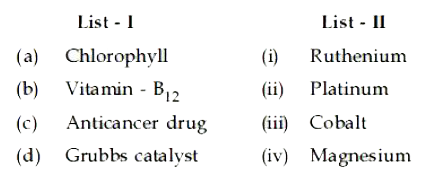
Choose the most appropriate answer from the options given below :
View SolutionMatch list - I with List - II :

Choose the most appropriate answer from the options given below :
View SolutionMatch List -I with List -II :

Choose the most appropriate answer from the options given below :
View SolutionMatch List-I with List-II :
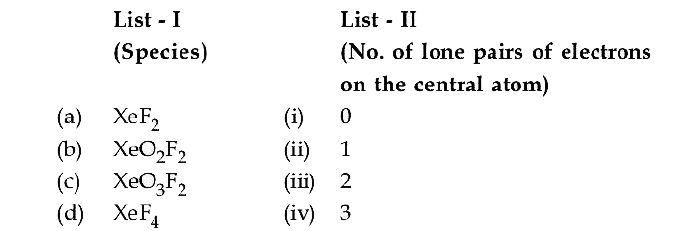
Choose the most appropriate answer from the options given below :
View SolutionMatch List-I with List-II :

Choose the most appropriate answer from the options given below :
View Solution


